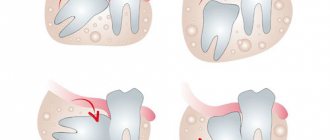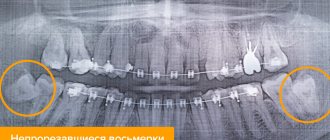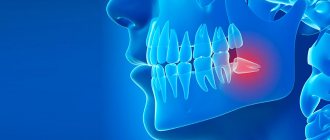In this article
- What is a wisdom tooth and where is it located?
- Why does figure eight caries occur?
- A wisdom tooth affected by caries - treat or remove?
- Pros and cons of treatment tactics for wisdom teeth for caries
- In what cases does wisdom tooth treatment make no sense and must be removed?
- Pros and cons of removal tactics for caries of the lower or upper eights
- Step-by-step treatment of wisdom tooth caries
- How is a wisdom tooth removed?
- Is it necessary to place an implant instead of a removed figure eight?
When caries is detected, there is usually no question of what to do. He is treated immediately. But if caries is found on a wisdom tooth, a person may be faced with a choice - to treat or remove it. We will tell you in this article how to deal with caries of eights correctly.
What is a wisdom tooth and where is it located?
The name “wisdom tooth” is assigned to the third molar, the so-called figure eight, the eighth tooth in a row. The period of wisdom teeth eruption is approximately from 20 to 27 years. In rare cases, they appear after 40 years. It is precisely with the age of eruption that the name of eights—“wisdom teeth”—is associated, because in fact they appear in a person during the period of maximum maturity of the body.
It is interesting that in some people, despite the presence of the rudiments of teeth, they may not erupt throughout their lives. Scientists explain this fact by the fact that in the process of evolution, modern people's jaw has become shorter by about 12 mm compared to their ancestors, which is due to softer food, when chewing which there is no heavy load on the jaw.
If figure eights do erupt, they often cause pain and discomfort to the person. If the jaw is small, then in the process of growth the eights can shift the dentition, which leads to the curvature of other teeth. Therefore, many people try to remove them whenever possible. But the very fact of having a “wise” tooth is not always a reason for its removal.
Why does figure eight caries occur?
According to statistics, caries of problem eights is much more common than caries of other teeth. At the same time, the main reasons for the development of carious lesions are not much different from those with damage to any other part of the jaw. These include:
- Hereditary factors.
- Poor hygiene.
- Excess sugars and fast carbohydrates in daily nutrition.
- A specific risk factor is the location of the third molar. Typically, the wisdom tooth erupts at an angle, which makes it difficult to properly clean it during daily hygiene procedures. In hard-to-reach areas, food debris accumulates, which serves as a breeding ground for bacteria. By fermenting carbohydrates, bacteria produce organic acid, which leads to caries of the upper or lower 8 teeth.
A wisdom tooth affected by caries - treat or remove?
According to statistics, when affected by caries, in approximately 20% of cases, the wisdom tooth can be treated, in 80% it can be removed immediately. The question of treating or removing figure eights is decided by the dentist, taking into account the individual characteristics of a particular patient.
In what cases can experienced dentists treat caries of third molars:
- If the tooth is in satisfactory condition, the carious lesion is superficial or in the stain stage and there are no obstacles to successful treatment.
- It is very desirable to treat wisdom tooth caries if for some reason the patient has had his sixth or seventh teeth removed and the eights bear a large chewing load.
- Treatment of a wisdom tooth affected by caries is also necessary if the figure eights act as a support for orthopedic structures - bridges, crowns.
- Treatment is acceptable if there is no gingival “hood” hanging over the dental crown.
- It is advisable to preserve the tooth even if the opposite jaw also has a figure eight.
How long will the extracted tooth hurt?
Let's start with the fact that the tooth itself will not hurt, since it has already been removed. Of course, for the first time after the procedure, the patient will continue to experience soreness and swelling of the gums. To eliminate them, the dentist will always recommend taking effective painkillers. As a rule, all unpleasant sensations disappear within 2–3 days after the operation.
Note! If the medications recommended by the doctor do not relieve the toothache, it intensifies, spreads to the entire jaw, or does not resolve after 2–3 days, then it is imperative to seek help from a specialist.
Wisdom teeth removal with 20% discount
Moscow
In what cases does wisdom tooth treatment make no sense and must be removed?
- If the dentist has diagnosed “deep caries of the wisdom tooth,” it makes no sense to treat the disease at this stage. In this case, the tooth is simply removed.
- Figure eights affected by caries are removed if they are incorrectly located in the row of the masticatory-maxillary system.
- Extraction (removal) is carried out for chronic recurrent pericoronitis - if the patient regularly has inflamed gums around the eighth tooth.
- The figure eight should be removed if it injures the soft tissues of the inside of the cheeks. This happens when wisdom teeth are incorrectly positioned.
- Treatment of eighth teeth is not carried out if the patient cannot fully open his mouth or there are other obstacles to the procedure.
- Caries will not be treated if the third molars violate the position of the dentition and cause crowding of the canines and incisors. In such situations, the doctor often removes the figure eights and then performs orthodontic correction of the displaced teeth.
- Basal caries and cervical caries of wisdom teeth are also indications for removal in most cases.
Features of the eighth teeth
Wisdom teeth close the row of teeth on both sides. A highly qualified dentist is able to reach them safely and treat them. This will take more effort and time, but saving the organ is quite possible.
The difficulty of treating the canals of premolars and molars is explained by the frequent curvature of tooth roots and canals, and in addition to the fact that the patient is simply not able to open his mouth wide enough to provide the doctor with direct access to the affected area. Select people react acutely to such deep touches and show a predisposition to develop a gag reflex. Therefore, the doctor does not always treat wisdom teeth efficiently, hence the high percentage of complications in the treatment of dental pulpitis.
A person, when coming to an appointment, must understand - after consulting a dentist - that the decision to save a tooth will have to be made independently. The doctor will invariably receive his earnings - either by performing therapy or by removing the organ. The main thing is that his intervention brings benefit to the patient.
Pros and cons of removal tactics for caries of the lower or upper eights
Advantages of the extraction (removal) method:
- it is possible to completely eliminate the infectious focus, prevent the spread of the inflammatory process to adjacent teeth and nearby tissues;
- eliminates the risk of crowded teeth and the need for orthodontic correction;
- the risk of recurrent caries is eliminated;
- removal of the third molar allows you to radically solve the issue of pain in the area of this tooth.
The negative aspects of removing wisdom teeth include the risk of postoperative complications, as well as the inability to install a support for bridges or crowns on the figure eights, if necessary.
Treatment or removal during pregnancy
In cases where a wisdom tooth is cut and hurts, causing constant discomfort to the pregnant woman, it can and should be treated regardless of the gestational age. If there is no acute pain and treatment can be postponed, then it is advisable to carry it out in the second trimester of pregnancy or after childbirth.
It is worth remembering that wisdom tooth removal, especially under anesthesia, is definitely contraindicated for pregnant women. Removing third molars is strongly not recommended due to the complexity of such an operation and the risk of developing postoperative complications. As for anesthesia, it cannot be used either for removal or for treatment - during pregnancy, only local anesthesia can be used, and the drugs should be selected very carefully and taking into account the patient’s condition.
Despite their name, wisdom teeth do not bring their owners increased intellectual abilities, but they can cause a number of very unpleasant problems with oral health. Typically, third molars “lead with them” swelling of the gums, purulent inflammation, the development of caries of neighboring teeth, as well as severe pain. Therefore, in modern dentistry they prefer to remove them, without waiting for serious complications to arise and longer and more expensive treatment to be required. In many European countries today, a common practice is to remove the “eights” immediately after their appearance, regardless of their condition and the correctness of eruption.
Step-by-step treatment of wisdom tooth caries
If the dentist gave a positive answer to the question of whether to treat wisdom teeth, it is necessary to begin treatment as early as possible, before caries reaches a more advanced stage. The treatment procedure for third molars is slightly different from the treatment of other teeth in the upper or lower jaw, since due to the special arrangement of the teeth, the doctor cannot use all available technologies.
Treatment occurs in several stages:
- After anesthesia, the dentist carefully prepares the cavity and, using a drill and hand instruments, removes all tissue affected by caries.
- To prevent infection from entering the body, he treats the oral cavity and the tooth itself with an antiseptic solution.
- The dentist places a healing or insulating pad inside the cleaned cavity.
- A seal made of photocomposite material is installed on top of the gasket. It is applied in layers, and each layer is illuminated with a special lamp until completely cured.
- After filling, the tooth is adjusted to the bite, given the correct anatomical shape, ground and polished.
How is a wisdom tooth removed?
Depending on a number of factors, the removal procedure can be simple or complex. If there are a small number of roots or their weak connection with the jaw, removing a tooth will not be difficult; the entire procedure will take about 20 minutes.
If the tooth is in the wrong position, has not grown completely, is located under the gum, has fused with the jaw, the roots are intertwined with the roots of other teeth, or a cyst has formed, in such situations the removal procedure will be difficult and will take at least an hour.
Any removal of third molars is a dental procedure performed under local anesthesia. It should be performed by an experienced dental surgeon, so contact only reliable clinics.
The removal procedure occurs in several stages:
- First, an x-ray is taken so that the doctor can understand the exact location of the tooth.
- The specialist selects anesthesia taking into account individual tolerance and gives an anesthetic injection.
- After a few minutes, when the anesthesia takes effect, the removal begins directly. Depending on the complexity, the procedure will take from 20 to 60 minutes.
- The doctor carefully makes incisions, removes the affected wisdom tooth, then treats the jaw with antiseptics and, if necessary, applies stitches.
- After the procedure, the dentist gives recommendations on how to care for your mouth and teeth after surgery. Typically, you should not eat for a couple of hours after the procedure, and you should not rinse your mouth forcefully for a while.
- If inflammation is present, the patient is prescribed antibacterial drugs. They will stop the inflammatory process and prevent the risk of infection spreading to other tissues.
How long does it take for gums to heal after wisdom tooth removal?
The healing process of the gums after the removal of the figure eight takes place in several stages.
- Healing of the hole takes 2–3 weeks after surgery.
- Formation of new bone tissue - up to 2 months from the moment of healing of the hole.
- Compaction of newly formed bone tissue – up to 4 months from the moment of formation.
- Complete fusion of gum and new bone tissue – up to 10 – 12 months from the date of removal.
The healing process of wounds and gums is purely individual. The speed of its progression is influenced by a number of important factors - the physiological characteristics of the body, the age of the patient, the characteristics of the immune system, postoperative care, the complexity of the operation performed (dissection of the gums, excision of the hood, etc.). During this period, it is important to follow all the recommendations of your doctor and carefully monitor your general well-being.
Is it necessary to place an implant instead of a removed figure eight?
Theoretically, a dental implant can be placed in place of an extracted wisdom tooth that has been affected by caries. But in practice this is not done for a number of reasons. Firstly, the anatomical location of the tooth makes such implantation extremely difficult. Secondly, the load on the eighth tooth will sooner or later lead to loosening of the rod on which the implant is attached. Food will get into the gaps formed and microbes will multiply, which can lead to inflammation. Thirdly, even with proper installation of the implant, there will still be a joint between the gum and the crown, in which bacteria will accumulate if hygiene is difficult.
And finally, replacing a removed figure eight with an implant does not make practical sense, especially if a person’s other chewing teeth function normally. Also, the absence of these teeth does not impair the quality of life and does not affect human health. Therefore, after removing the third molar, there is no need to install an implant in its place.
In order to answer this question, let’s figure out what kind of wisdom teeth they are.
It is not without reason that wisdom teeth received such an interesting name; many beliefs and legends are associated with them. The ancients believed that a person develops these teeth (17 - 25 years old) only when his soul has strengthened, become mature, and life wisdom has appeared. The eruption of all 4 teeth indicated the protection of the clan, so they were practically not removed - because then the person was deprived of protection.
These teeth are also called “eights”, as they are the eighth in the dentition. Wisdom teeth are unique because they are the only group of teeth that do not have a clear anatomy, and for the most part they are all different. It is impossible to be unambiguously sure of the number of root canals and their patency.
Nature has endowed humans with “figure eights” so that the teeth are located closer to each other and to make chewing hard food easier. Now this problem has lost its relevance. In the modern world, we eat softer food, so wisdom teeth began to grow much later than others and not in all people, so “eights” are considered to be rudiments. According to data, 15 - 20% of the population have no wisdom teeth at all, not even the rudiments. The rest have rudiments, but often they prefer to remain in the thickness of the jaw and not rise to the surface. And only some “lucky” ones can experience the beauty of teething already in adulthood.
The unpleasant sensations that wisdom teeth sometimes cause can be safely blamed on the process of evolution. Over the millennia, the human body has transformed, and the jaw is no exception. Gradually it decreased, but the size of the teeth did not change. Because of this, wisdom teeth, which are the last to grow, do not have enough space in the mouth.
Wisdom teeth, indeed, are almost not involved in the chewing process. But you shouldn’t neglect them either, since a fully erupted wisdom tooth in the event of loss of other teeth can “save” a person from removable dentures.
In what cases is it worth fighting to preserve a wisdom tooth?
Arguments for"
A wisdom tooth that has completely erupted and is affected by caries can and should be treated. If the canals are well passable, not curved and can be filled with high quality, even complications of caries (pulpitis, periodontitis) are not a “sentence” for these teeth.
There is one advantage in the “eights”, because of which some patients try to save them. Erupting later than others, wisdom teeth can become a support for a bridge prosthesis - instead of damaged teeth. Without the figure eight, such permanent prosthetics will only be possible with the help of implants.
A wisdom tooth may definitely be required for prosthetics if: the seventh tooth in front is missing, both the sixth and seventh teeth are missing, or the sixth and seventh teeth have not yet been removed, but will soon be removed.
Definitely delete!
Delayed eruption (retention), incorrect position (dystopia) of the wisdom tooth
As a rule, this is a partially erupted wisdom tooth, lying horizontally or with its crown tilted towards the lingual, buccal, medial (inclined towards the “seventh” tooth), distal (towards the angle of the jaw) sides. The value of such a tooth for prosthetics and chewing food is zero. It happens that the crown of a wisdom tooth has a pronounced slope towards the cheek area. This leads to the person biting his cheek all the time. Chronic injury to the buccal mucosa can even lead to the development of an oncological process in this area. There is no point in preserving such teeth.
2) Destruction of the front (“seventh”) tooth
As mentioned above, wisdom teeth often erupt at an angle. The front cusps of the crown sometimes rest against the seventh tooth in front. Lack of adequate hygiene and constant pressure from the wisdom tooth on the enamel of the nearby tooth can cause its destruction and the occurrence of caries. Preserving the seventh tooth and its full treatment is sometimes not possible without removing the wisdom tooth.
3) Orthodontic indications (bite anomalies).
Previously, to correct the bite, “fourth” teeth (less often “fifth” teeth) were often removed for subsequent orthodontic treatment. These teeth are located in the smile line and from an aesthetic point of view, it is currently more advisable to preserve them. Therefore, removal of wisdom teeth is the right decision, since they can provoke relapse after early orthodontic treatment, due to later eruption. In addition to removing impacted wisdom teeth, orthodontists recommend removing even the rudiments of these teeth.
4) Pericoronitis (inflammation of the mucous hood).
A fully or partially erupted wisdom tooth occupies such a position that part of its crown is covered with an overhanging hood of mucous membrane. In this case, a space is formed between the hood and the tooth in which microbes multiply, which leads to inflammation. In such cases, patients, as a rule, note aching pain in the jaw, discomfort when opening the mouth (sometimes limited mouth opening caused by inflammatory muscle contracture), pain when swallowing, enlarged lymph nodes, and sometimes swelling of the cheek appears. In this case, to stop the inflammatory process, the mucous hood is excised, followed by anti-inflammatory therapy. Such inflammations can happen more than once, so the only correct solution is to remove the wisdom tooth.
There are situations when it is impossible to maintain the “eight”, and inaction is dangerous!
These are inflammatory processes caused by wisdom teeth. Periostitis (inflammation of the periosteum of the jaw). Initially, complaints appear of aching pain in the tooth, which intensifies when biting (a symptom of an “overgrown” tooth). If the patient ignores these pains, the inflammatory process spreads to the periosteum. In such cases, swelling appears and general health worsens. At the same time, pain in the tooth decreases. In case of extensive destructive process on the roots, the tooth is removed with dissection of the periosteum (periostotomy) and subsequent drainage of the lesion.
More serious complications are osteomyelitis (inflammation of the jaw), abscesses and phlegmons (limited and widespread purulent processes of soft tissues), abscessing lymphadenitis (purulent melting of the lymph nodes) and others. These diseases are an indication for the removal of wisdom teeth, followed by serious treatment in a hospital.
Summarizing all of the above, I would like to focus on the fact that everything is very individual, and only after carefully weighing all the pros and cons, having received a comprehensive consultation with a doctor, should you make a decision regarding treatment or removal of a wisdom tooth.










